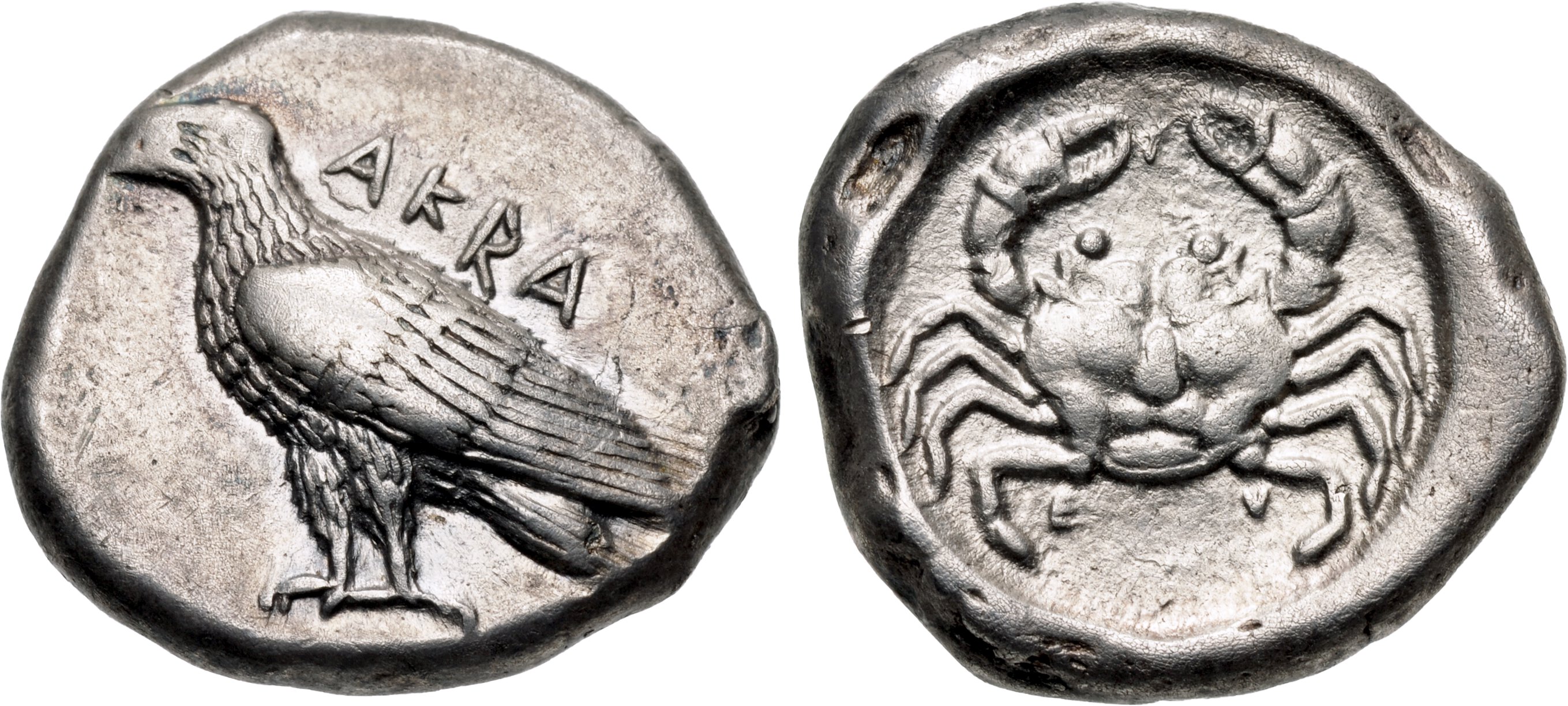Agrigentum, silver, didrachms (495-485 BCE)
From SILVER
495 BCE - 485 BCE Silver 4,682 kg
Description
| ObverseInscription or printing placed on the obverse.: | AKRA to right (Greek).Sea eagle standing left |
| ReverseInscription or printing placed on the reverse.: | Crab, tiny EV below, all within incuse circle |
Mint and issuing power
| MintIdentifies the place of manufacture or issue of a numismatic object.: | Agrigentum | Ancient regionAncient region.: | Sicily | Modern countryModern country: Italy | AuthorityIdentifies the issuing power. The authority can be "pretended" when the name or the portrait of X is on the coin but he/she was not the issuing power. It can also be "uncertain" when there is no mention of X on the coin but he/she was the issuing power according to the historical sources: |
Chronology
| FromIdentifies the initial date in a range assigned in a numismatic context. | 495 BCE | toIdentifies the final date in a range assigned in a numismatic context.. | 485 BCE | PeriodTime period of the numismatic object.: Archaic until 480 BC |
Physical description
| MetalThe physical material (usually metal) from which an object is made.: | Silver |
Median weightMedian of the weights of numismatic objects (in grams). in grams | 8.70 | DenominationTerm indicating the value of a numismatic object. Examples: tetradrachm, chalkous, denarius.: | didrachm |
StandardStandard.: |
Image

S 1491 - Agrigentum, silver, didrachms (495-485 BCE).jpg [1]
References
| Die study referencePublication of the study: | Westermark 20181Westermark 2018, p. 30-46, n° 90-153 (Period I, Group II) | ||
| Coin series referenceReference to coin series study: | HGC 22HGC 2, n° 94 | ||
Obverse dies distribution
| FrequencyFrequency of specimen in distribution. ᵖ | Number of obversesNumber of obverse dies. ᵖ (o) | % (o) | Number of coinsNumber of coins. (n) | % (n) | Die nameName(s) of the die(s). |
| 1 | 4 | 14.81 | 4 | 1.15 | 60;62;63;64 |
| 3 | 1 | 3.7 | 3 | 0.86 | 38 |
| 4 | 3 | 11.11 | 12 | 3.46 | 44;47;61 |
| 6 | 1 | 3.7 | 6 | 1.73 | 41 |
| 8 | 2 | 7.41 | 16 | 4.61 | 42;53 |
| 10 | 2 | 7.41 | 20 | 5.76 | 43;58 |
| 13 | 3 | 11.11 | 39 | 11.24 | 45;50;55 |
| 17 | 2 | 7.41 | 34 | 9.8 | 51;59 |
| 18 | 1 | 3.7 | 18 | 5.19 | 40 |
| 19 | 1 | 3.7 | 19 | 5.48 | 49 |
| 20 | 1 | 3.7 | 20 | 5.76 | 48 |
| 22 | 1 | 3.7 | 22 | 6.34 | 57 |
| 23 | 1 | 3.7 | 23 | 6.63 | 39 |
| 25 | 2 | 7.41 | 50 | 14.41 | 52;54 |
| 30 | 1 | 3.7 | 30 | 8.65 | 56 |
| 31 | 1 | 3.7 | 31 | 8.93 | 46 |
| Total | 27 of 27 | 99.97 | 347 of 347 | 100 |
Reverse dies distribution
no distribution is available
Quantification
| Number of obversesNumber of obverse dies. ᵖ (o) | 27 | Number of singletons (o1)The number of singleton coins. ᵖ | |
| Number of reverse diesNumber of reverse dies. (r) | 48 | Number of coinsNumber of coins. (n) | |
| Coins per obverse dieNumber of coins per obverse die. (n/o) | Coins per reverse dieNumber of coins per reverse die. (n/r) | ||
| Reverse per obverse ratioRatio of obverse dies divided by reverse dies. (r/o) | 1.78 | Percentage of singletons (o1)number of coins (n) divided by the number of singletons (o1) ᵖ | % |
| Original number of dies (O) (Carter 1983 formula)The estimation of the number of coins according to Carter 1983 ᵖ | Expression error: Unexpected / operator. | Coins struck if 20,000 as average productivity per dieCoins made if the average productivity for obverses (according to Carter) is 20,000. ᵖ | |
| Original number of dies (O) (Esty 2011 formula)The estimation of the number of coins according to the singleton formula in Esty 2011 ᵖ (O) | Survival rate if 20,000 as average productivity per dieSurvival rate if average productivity is 20,000. ᵖ | 0.00064 | |
| Coverage (o = % of O) (Esty 1984 formula)Esty 1984 - coverage (% of O) ᵖ (o = % of O) | % | Die productivity if survival rate 1/2,000Average productivity if survival rate is 1/2,000. ᵖ | |
| Weight of silver (in kg) if 20,000 coins per die (O = Carter formula)Carter 1983 * Median weight * 20000 (*10 if gold or electrum) ᵖ | 4,682 kg | Die productivity if survival rate 1/5,000Average productivity if survival rate is 1/5,000. ᵖ |
Remarks
References
- ^ Westermark, Ulla (2018), The coinage of Akragas c. 510-406 BC, 2 vol., Uppsala.
- ^ Hoover, Oliver D. (2012), The Handbook of Greek Coinage Series. 2. Handbook of the Coins of Sicily (Including Lipara). Civic, Royal, Siculo-Punic, and Romano-Sicilian Issues. Sixth to First Centuries BC, Lancaster-London, 489 p.